Apps
Auto Added by WPeMatico
Auto Added by WPeMatico
A third-party contacts app you’re not using may be handing out your home address to its users. In November, former Yahoo CEO and Google veteran Marissa Mayer and co-founder Enrique Muñoz Torres introduced their newly rebranded startup Sunshine, and its first product, Sunshine Contacts. The new iOS app offers to organize your address book by handling duplicates and merges using AI technology, as well as fill in some of the missing bits of information by gathering data from the web — like LinkedIn profiles, for example.
But some users were surprised to find they suddenly had home addresses for their contacts, too, including for those who were not already Sunshine users.
TechCrunch reached out to Sunshine to better understand the situation, given the potential privacy concerns.
We understand there are several ways that users may encounter someone’s home address in the Sunshine app. A user may already have the address on file in their phone’s address book, of course, or they may have opted in to allow Sunshine to scan their inbox in order to extract information from email signature lines. This is a feature common to other personal CRM solutions, too, like Evercontact.
In the event that someone had signed an email with their home address included in this field, that data could then be added to their contact card in the Sunshine app. In this case, the contact card is updated in the Sunshine Contacts app, which then syncs with your phone’s address book. But this data is not distributed to any other app users.
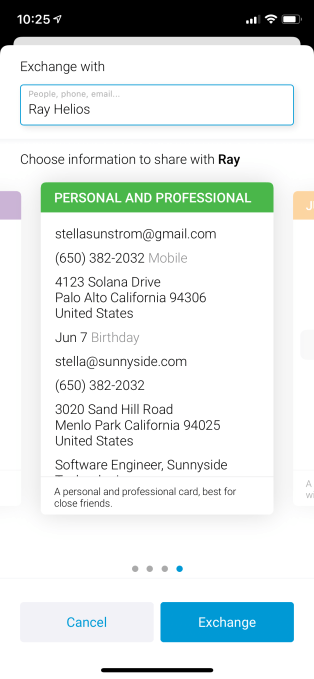
Image Credits: Sunshine
The app also augments contact cards with information acquired by other means. For example, it may use the information you do have to complete missing fields — like adding a last name, when you had other data that indicated what someone’s full name is, but hadn’t completed filling out the card. The app may also be able to pull in data from a LinkedIn profile, if available.
For home addresses, Sunshine is using the Whitepages API.
The company confirmed to TechCrunch it’s augmenting contact cards with home addresses under some circumstances, even if that contact is not a Sunshine Contacts user. Sunshine says it doesn’t believe this to be any different from a user going to Google to look for someone’s contact information on the web — it’s just automating the process.
Of course, some would argue when you’re talking about automating the collection of home addresses for hundreds or potentially thousands of users — depending on the size of your personal address book database — it’s a bit different than if you went googling to find your aunt’s address so you can mail a Christmas card or called your old college roommate to find out where to send their birthday gift.
However, Sunshine clarified to TechCrunch that it won’t add the home address except in cases when it determines you have a personal connection to the contact in question.
Here, though, Sunshine enters a gray area where the app and its technology will try to figure out who you know well enough to need a home address.
Before adding the address, Sunshine requires you to have the contact’s phone number on file in your address book, not just their email. That would eliminate some people you only have a loose connection with through work, for instance. And it only updates with the home address if the partner API is able to associate that address with a phone number you have.
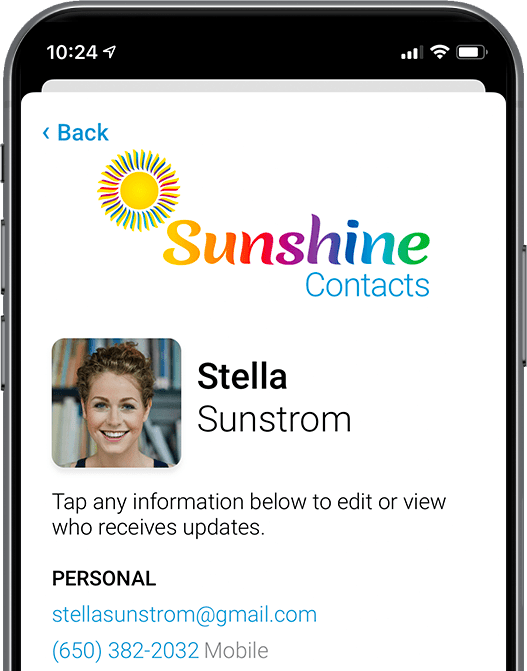
Image Credits: Sunshine
In addition, Sunshine says that it’s generally able to understand the type of phone number you have on file — like if it’s a residential or business line, or if it’s a landline or mobile number. (It uses APIs to do this, similar to StrikeIron’s though not that particular one.) It also knows who the phone number belongs to. Using this information and further context, the app tries to determine if a phone number is a personal or a professional number and it will try to understand your relationship with the person who owns that number.
In practice, what this means is that if all the information you had on file for a contact was professional information — where they worked, a job title, a work email and a phone number, perhaps — then that person’s contact card would not be updated to include their home address, too.
And because many people use their personal cell for work, Sunshine won’t consider someone a “personal” relationship just because you have their mobile phone number. For example, if you had only a contact’s name and a cell number, you wouldn’t be able to use the app to get their home address.
The result of all this automated analysis is that Sunshine, in theory, only updates contact cards with home addresses where it’s determined there’s a personal relationship.
This, of course, doesn’t take into account some scenarios like bad exes, stalking or a general desire for privacy. Arguably, there are times when someone may have a lot of personal information for a contact in their address book, but the contact in question would rather not have their home address distributed to that person.
The only way to prevent this, presumably, would be to opt out at the source: Whitepages.com. (Once you have your profile URL from the Whitepages website, you can use this online form to have your information suppressed.)
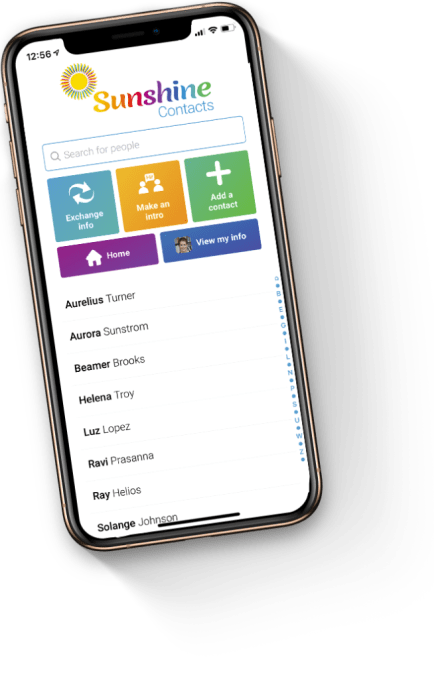
Image Credits: Sunshine
The way the app functions raises questions about what is truly private information these days.
Sunshine points out that people’s home addresses are not as hidden from the world as they may think, which makes them fair game.
It’s true that our home addresses are often publicly available. Although it’s been years since most of us have had a telephone directory dropped on our doorstep with phone and address listings for people in our city, home addresses today are relatively trivial to find when you know where to look online.
In addition to public records — like voter registration databases — there are web-based people finders, too.
Sunshine’s partner, Whitepages.com, makes visitors pay for its data, but others like TruePeopleSearch.com don’t have the same paywall. With someone’s first and last name and city, its website provides access to someone’s home address, prior addresses, cell phone, age and the names of family members and other close associates. (TruePeopleSearch is not a Sunshine partner, we should clarify.)
Even though this data is “public,” it’s uncomfortable to see it casually distributed in an app, as that makes it even easier to get to than before.
Plus, after years of being burned by data breaches and data privacy scandals, people tend to be more protective of their personal information than before. And, had they been asked, many would probably decline to have their home addresses shared with Sunshine’s user base. Generally speaking, people appreciate the courtesy of having someone come ask for a home address, when it’s needed — they may not want an app creeping the web to find it and hand it out.
Sunshine Contacts is in an invite-only beta in the U.S., so the company has time to reconsider how this feature is implemented based on user feedback before it becomes widely available.
Powered by WPeMatico
Calm, a well-known meditation app, has raised new capital at a valuation of $2 billion. The round was anticipated after the company was reported to be hunting for up to $150 million at a valuation of $2.2 billion; perhaps Calm will follow in the steps of Robinhood and add a second tranche to the round in time.
Prior investor Lightspeed Venture Partners led the investment, which also saw participation from Insight, TPG and Salesforce CEO and new Slack owner Marc Benioff, among others.
That Calm was able to secure more capital is not surprising. The company has a history of quick revenue growth, and is reportedly profitable, to boot. And the investment comes after mental health-focused startups as a category have performed well from a venture capital perspective.
The coronavirus pandemic has likely also played into Calm’s attractiveness as an investment. Since the beginning, researchers have warned about the psychological toll that a pandemic could have on humanity. A recent Pew Research study suggested that people who have lost their jobs during the pandemic might be feeling higher levels of distress during this time. Rival service Headspace offered an annual subscription to its platform for free for those that are unemployed.
Calm responded to the toll of coronavirus by launching a page of free resources, and focusing on a partnership with nonprofit health system Kaiser Permanente. Kaiser was the first health system to make Calm app’s Premium subscription free for its members.
The startups sells a consumer service for around $70 per year, or $15 per month. And the startup has built out a corporate arm, “Calm for Business,” that likely brings revenue stability that augments its consumer efforts.
As part of a release concerning today’s news, Calm detailed a number of nearly useful growth metrics. The service has over 100 million downloads, up from 40 million downloads in February 2019. It also grew up from 1 million paying users to 4 million paying users in the same time period (we asked if that data was inclusive of any Calm for Business customers, a question Calm did not answer).
Other TechCrunch queries regarding the company’s economics, revenue growth and performance compared to its pre-COVID plan also went unanswered.
Calm and rival service Headspace have now raised a combined $434 million according to Crunchbase data, underscoring how attractive their models have proved to venture capitalists. According to a Bloomberg interview, Calm is considering acquiring smaller companies in the wake of its new capital event.
Regardless, Calm now has a refreshed war chest heading into 2021 and a plan to go hunting. That should generate a headline or two.
Powered by WPeMatico
Sanguina, an Atlanta-based health technology developer, is launching a mobile app in the Google Play Store that uses pictures of fingernails to determine whether or not someone is getting enough iron.
The app measures hemoglobin levels, which are a key indicator of anemia, by analyzing the color of a person’s fingernail beds in a picture.
These fingernail selfies could be used to determine anemia for the more than 2 billion people who are affected by the condition — including women, children, athletes and the elderly.
Iron deficiencies can cause fatigue, pregnancy complications and, in severe cases, even cardiac arrest, the company said. AnemoCheck is the first smartphone application to measure hemoglobin levels, the company said — and through its app people can not only determine whether or not they’re anemic but also use the app’s information to address the condition, the company said.
Sanguina’s technology uses an algorithm to determine the amount of hemoglobin in the blood based on an examination and analysis of the coloration of the nail bed.
Created by Dr. Wilbur Lam, Erika Tyburski and Rob Mannino, the company was born out of research conducted at the Georgia Institute of Technology and Emory University.
“This non-invasive anemia detection tool is the only type of app-based system that has the potential to replace a common blood test,” said Dr. Lam, a clinical hematologist-bioengineer at the Aflac Cancer and Blood Disorders Center of Children’s Healthcare of Atlanta, associate professor of pediatrics at Emory University School of Medicine and a faculty member in the Wallace H. Coulter Department of Biomedical Engineering at Emory University and Georgia Tech.
So far, Sanguina has raised more than $4.2 million in funding from The Seed Lab, XRC Labs and grants from The National Science Foundation and The National Institutes of Health, according to a statement.
Powered by WPeMatico
As TC readers know, the tricky trade-off of the modern web is privacy for convenience. Online tracking is how this ‘great intimacy robbery’ is pulled off. Mass surveillance of what Internet users are looking at underpins Google’s dominant search engine and Facebook’s social empire, to name two of the highest profile ad-funded business models.
TechCrunch’s own corporate overlord, Verizon, also gathers data from a variety of end points — mobile devices, media properties like this one — to power its own ad targeting business.
Countless others rely on obtaining user data to extract some perceived value. Few if any of these businesses are wholly transparent about how much and what sort of private intelligence they’re amassing — or, indeed, exactly what they’re doing with it. But what if the web didn’t have to be like that?
Berlin-based Xayn wants to change this dynamic — starting with personalized but privacy-safe web search on smartphones.
Today it’s launching a search engine app (on Android and iOS) that offers the convenience of personalized results but without the ‘usual’ shoulder surfing. This is possible because the app runs on-device AI models that learn locally. The promise is no data is ever uploaded (though trained AI models themselves can be).
The team behind the app, which is comprised of 30% PhDs, has been working on the core privacy vs convenience problem for some six years (though the company was only founded in 2017); initially as an academic research project — going on to offer an open source framework for masked federated learning, called XayNet. The Xayn app is based on that framework.
They’ve raised some €9.5 million in early stage funding to date — with investment coming from European VC firm Earlybird; Dominik Schiener (Iota co-founder); and the Swedish authentication and payment services company, Thales AB.
Now they’re moving to commercialize their XayNet technology by applying it within a user-facing search app — aiming for what CEO and co-founder, Dr Leif-Nissen Lundbæk bills as a “Zoom”-style business model, in reference to the ubiquitous videoconferencing tool which has both free and paid users.
This means Xayn’s search is not ad-supported. That’s right; you get zero ads in search results.
Instead, the idea is for the consumer app to act as a showcase for a b2b product powered by the same core AI tech. The pitch to business/public sector customers is speedier corporate/internal search without compromising commercial data privacy.
Lundbæk argues businesses are sorely in need of better search tools to (safely) apply to their own data, saying studies have shown that search in general costs around 18% of working time globally. He also cites a study by one city authority that found staff spent 37% of their time at work searching for documents or other digital content.
“It’s a business model that Google has tried but failed to succeed,” he argues, adding: “We are solving not only a problem that normal people have but also that companies have… For them privacy is not a nice to have; it needs to be there otherwise there is no chance of using anything.”
On the consumer side there will also be some premium add-ons headed for the app — so the plan is for it to be a freemium download.
One key thing to note is Xayn’s newly launched web search app gives users a say in whether the content they’re seeing is useful to them (or not).
It does this via a Tinder-style swipe right (or left) mechanic that lets users nudge its personalization algorithm in the right direction — starting with a home screen populated with news content (localized by country) but also extending to the search result pages.
The news-focused homescreen is another notable feature. And it sounds like different types of homescreen feeds may be on the premium cards in future.
Another key feature of the app is the ability to toggle personalized search results on or off entirely — just tap the brain icon at the top right to switch the AI off (or back on). Results without the AI running can’t be swiped, except for bookmarking/sharing.
Elsewhere, the app includes a history page which lists searches from the past seven days (by default). The other options offered are: Today, 30 days, or all history (and a bin button to purge searches).
There’s also a ‘Collections’ feature that lets you create and access folders for bookmarks.
As you scroll through search results you can add an item to a Collection by swiping right and selecting the bookmark icon — which then opens a prompt to choose which one to add it to.
The swipe-y interface feels familiar and intuitive, if slightly laggy to load content in the TestFlight beta version TechCrunch checked out ahead of launch.
Swiping left on a piece of content opens a bright pink color-block stamped with a warning ‘x’. Keep going and you’ll send the item vanishing into the ether, presumably seeing fewer like it in future.
Whereas a swipe right affirms a piece of content is useful. This means it stays in the feed, outlined in Xayn green. (Swiping right also reveals the bookmark option and a share button.)
While there are pro-privacy/non-tracking search engines on the market already — such as US-based DuckDuckGo or France’s Qwant — Xayn argues the user experience of such rivals tends to fall short of what you get with a tracking search engine like Google, i.e. in terms of the relevance of search results and thus time spent searching.
Simply put: You probably have to spend more time ‘DDGing’ or ‘Qwanting’ to get the specific answers you need vs Googling — hence the ‘convenience cost’ associated with safeguarding your privacy when web searching.
Xayn’s contention is there’s a third, smarter way of getting to keep your ‘virtual clothes’ on when searching online. This involves implementing AI models that learn on-device and can be combined in a privacy-safe way so that results can be personalized without putting people’s data at risk.
“Privacy is the very fundament… It means that quite like other privacy solutions we track nothing. Nothing is sent to our servers; we don’t store anything of course; we don’t track anything at all. And of course we make sure that any connection that is there is basically secured and doesn’t allow for any tracking at all,” says Lundbæk, explaining the team’s AI-fuelled, decentralized/edge-computing approach.
Xayn is drawing on a number of search index sources, including (but not solely) Microsoft’s Bing, per Lundbæk, who described this bit of what it’s doing as “relatively similar” to DuckDuckGo (which has its own web crawling bots).
The big difference is that it’s also applying its own reranking algorithms in order generate privacy-safe personalized search results (whereas DDG uses a contextual ads-based business model — looking at simple signals like location and keyword search to target ads without needing to profile users).
The downside to this sort of approach, according to Lundbæk, is users can get flooded with ads — as a consequence of the simpler targeting meaning the business serves more ads to try to increase chances of a click. And loads of ads in search results obviously doesn’t make for a great search experience.
“We get a lot of results on device level and we do some ad hoc indexing — so we build on the device level and on index — and with this ad hoc index we apply our search algorithms in order to filter them, and only present you what is more relevant and filter out everything else,” says Lundbæk, sketching how Xayn works. “Or basically downgrade it a bit… but we also try to keep it fresh and explore and also bump up things where they might not be super relevant for you but it gives you some guarantees that you won’t end up in some kind of bubble.”
Some of what Xayn’s doing is in the arena of federated learning (FL) — a technology Google has been dabbling in in recent years, including pushing a ‘privacy-safe’ proposal for replacing third party tracking cookies. But Xayn argues the tech giant’s interests, as a data business, simply aren’t aligned with cutting off its own access to the user data pipe (even if it were to switch to applying FL to search).
Whereas its interests — as a small, pro-privacy German startup — are markedly different. Ergo, the privacy-preserving technology it’s spent years building has a credible interest in safeguarding people’s data, is the claim.
“At Google there’s actually [fewer] people working on federate learning than in our team,” notes Lundbæk, adding: “We’ve been criticizing TFF [Google-designed TensorFlow Federated] at lot. It is federated learning but it’s not actually doing any encryption at all — and Google has a lot of backdoors in there.
“You have to understand what does Google actually want to do with that? Google wants to replace [tracking] cookies — but especially they want to replace this kind of bumpy thing of asking for user consent. But of course they still want your data. They don’t want to give you any more privacy here; they want to actually — at the end — get your data even easier. And with purely federated learning you actually don’t have a privacy solution.
“You have to do a lot in order to make it privacy preserving. And pure TFF is certainly not that privacy-preserving. So therefore they will use this kind of tech for all the things that are basically in the way of user experience — which is, for example, cookies but I would be extremely surprised if they used it for search directly. And even if they would do that there is a lot of backdoors in their system so it’s pretty easy to actually acquire the data using TFF. So I would say it’s just a nice workaround for them.”
“Data is basically the fundamental business model of Google,” he adds. “So I’m sure that whatever they do is of course a nice step in the right direction… but I think Google is playing a clever role here of kind of moving a bit but not too much.”
So how, then, does Xayn’s reranking algorithm work?
The app runs four AI models per device, combining encrypted AI models of respective devices asynchronously — with homomorphic encryption — into a collective model. A second step entails this collective model being fed back to individual devices to personalize served content, it says.
The four AI models running on the device are one for natural language processing; one for grouping interests; one for analyzing domain preferences; and one for computing context.
“The knowledge is kept but the data is basically always staying on your device level,” is how Lundbæk puts it.
“We can simply train a lot of different AI models on your phone and decide whether we, for example, combine some of this knowledge or whether it also stays on your device.”
“We have developed a quite complex solution of four different AI models that work in composition with each other,” he goes on, noting that they work to build up “centers of interest and centers of dislikes” per user — again, based on those swipes — which he says “have to be extremely efficient — they have to be moving, basically, also over time and with your interests”.
The more the user interacts with Xayn, the more precise its personalization engine gets as a result of on-device learning — plus the added layer of users being able to get actively involved by swiping to give like/dislike feedback.
The level of personalization is very individually focused — Lundbæk calls it “hyper personalization” — more so than a tracking search engine like Google, which he notes also compares cross-user patterns to determine which results to serve — something he says Xayn absolutely does not do.
“We have to focus entirely on one user so we have a ‘small data’ problem, rather than a big data problem,” says Lundbæk. “So we have to learn extremely fast — only from eight to 20 interactions we have to already understand a lot from you. And the crucial thing is of course if you do such a rapid learning then you have to take even more care about filter bubbles — or what is called filter bubbles. We have to prevent the engine going into some kind of biased direction.”
To avoid this echo chamber/filter bubble type effect, the Xayn team has designed the engine to function in two distinct phases which it switches between: Called ‘exploration’ and (more unfortunately) ‘exploitation’ (i.e. just in the sense that it already knows something about the user so can be pretty certain what it serves will be relevant).
“We have to keep fresh and we have to keep exploring things,” he notes — saying that’s why it developed one of the four AIs (a dynamic contextual multi-armed bandit reinforcement learning algorithm for computing context).
Aside from this app infrastructure being designed natively to protect user privacy, Xayn argues there are a bunch of other advantages — such as being able to derive potentially very clear interests signs from individuals; and avoiding the chilling effect that can result from tracking services creeping users out (to the point people they avoid making certain searches in order to prevent them from influencing future results).
“You as the user can decide whether you want the algorithm to learn — whether you want it to show more of this or less of this — by just simply swiping. So it’s extremely easy, so you can train your system very easily,” he argues.
There is potentially a slight downside to this approach, too, though — assuming the algorithm (when on) does some learning by default (i.e in the absence of any life/dislike signals from the user).
This is because it puts the burden on the user to interact (by swiping their feedback) in order to get the best search results out of Xayn. So that’s an active requirement on users, rather than the typical passive background data mining and profiling web users are used to from tech giants like Google (which is, however, horrible for their privacy).
It means there’s an ‘ongoing’ interaction cost to using the app — or at least getting the most relevant results out of it. You might not, for instance, be advised to let a bunch of organic results just scroll past if they’re really not useful but rather actively signal disinterest on each.
For the app to be the most useful it may ultimately pay to carefully weight each item and provide the AI with a utility verdict. (And in a competitive battle for online convenience every little bit of digital friction isn’t going to help.)
Asked about this specifically, Lundbæk told us: “Without swiping the AI only learns from very weak likes but not from dislikes. So the learning takes place (if you turn the AI on) but it’s very slight and does not have a big effect. These conditions are quite dynamic, so from the experience of liking something after having visited a website, patterns are learned. Also, only 1 of the 4 AI models (the domain learning one) learns from pure clicks; the others don’t.”
Xayn does seem alive to the risk of the swiping mechanic resulting in the app feeling arduous. Lundbæk says the team is looking to add “some kind of gamification aspect” in the future — to flip the mechanism from pure friction to “something fun to do”. Though it remains to be seen what they come up with on that front.
There is also inevitably a bit of lag involved in using Xayn vs Google — by merit of the former having to run on-device AI training (whereas Google merely hoovers your data into its cloud where it’s able to process it at super-speeds using dedicated compute hardware, including bespoke chipsets).
“We have been working for over a year on this and the core focus point was bringing it on the street, showing that it works — and of course it is slower than Google,” Lundbæk concedes.
“Google doesn’t need to do any of these [on-device] processes and Google has developed even its own hardware; they developed TPUs exactly for processing this kind of model,” he goes on. “If you compare this kind of hardware it’s pretty impressive that we were even able to bring [Xayn’s on-device AI processing] even on the phone. However of course it’s slower than Google.”
Lundbæk says the team is working on increasing the speed of Xayn. And anticipates further gains as it focuses more on that type of optimization — trailing a version that’s 40x faster than the current iteration.
“It won’t at the end be 40x faster because we will use this also to analyze even more content — to give you can even broader view — but it will be faster over time,” he adds.
On the accuracy of search results vs Google, he argues the latter’s ‘network effect’ competitive advantage — whereby its search reranking benefits from Google having more users — is not unassailable because of what edge AI can achieve working smartly atop ‘small data’.
Though, again, for now Google remains the search standard to beat.
“Right now we compare ourselves, mostly against Bing and DuckDuckGo and so on. Obviously there we get much better results [than compared to Google] but of course Google is the market leader and is using quite some heavy personalization,” he says, when we ask about benchmarking results vs other search engines.
“But the interesting thing is so far Google is not only using personalization but they also use kind of a network effect. PageRank is very much a network effect where the most users they have the better the results get, because they track how often people click on something and bump this also up.
“The interesting effect there is that right now, through AI technology — like for example what we use — the network effect becomes less and less important. So actually I would say that there isn’t really any network effect anymore if you really want to compete with pure AI technology. So therefore we can get almost as relevant results as Google right now and we surely can also, over time, get even better results or competing results. But we are different.”
In our (brief) tests of the beta app Xayn’s search results didn’t obviously disappoint for simple searches (and would presumably improve with use). Though, again, the slight load lag adds a modicum of friction which was instantly obvious compared to the usual search competition.
Not a deal breaker — just a reminder that performance expectations in search are no cake walk (even if you can promise a cookie-free experience).
“So far Google has so far had the advantage of a network effect — but this network effect gets less and less dominant and you see already more and more alternatives to Google popping up,” Lundbæk argues, suggesting privacy concerns are creating an opportunity for increased competition in the search space.
“It’s not anymore like Facebook or so where there’s one network where everyone has to be. And I think this is actually a nice situation because competition is always good for technical innovations and for also satisfying different customer needs.”
Of course the biggest challenge for any would-be competitor to Google search — which carves itself a marketshare in Europe in excess of 90% — is how to poach (some of) its users.
Lundbæk says the startup has no plans to splash millions on marketing at this point. Indeed, he says they want to grow usage sustainably, with the aim of evolving the product “step by step” with a “tight community” of early adopters — relying on cross-promotion from others in the pro-privacy tech space, as well as reaching out to relevant influencers.
He also reckons there’s enough mainstream media interest in the privacy topic to generate some uplift.
“I think we have such a relevant topic — especially now,” he says. “Because we want to show also not only for ourselves that you can do this for search but we think we show a real nice example that you can do this for any kind of case.
“You don’t always need the so-called ‘best’ big players from the US which are of course getting all of your data, building up profiles. And then you have these small, cute privacy-preserving solutions which don’t use any of this but then offer a bad user experience. So we want to show that this shouldn’t be the status quo anymore — and you should start to build alternatives that are really build on European values.”
And it’s certainly true EU lawmakers are big on tech sovereignty talk these days, even though European consumers mostly continue to embrace big (US) tech.
Perhaps more pertinently, regional data protection requirements are making it increasing challenging to rely on US-based services for processing data. Compliance with the GDPR data protection framework is another factor businesses need to consider. All of which is driving attention onto ‘privacy-preserving’ technologies.
Xayn’s team is hoping to be able spread its privacy-preserving gospel to general users by growing the b2b side of the business, according to Lundbæk — so it’s hoping some home use will follow once employees get used to convenient private search via their workplaces, in a small-scale reverse of the business consumerization trend that was powered by modern smartphones (and people bringing their own device to work).
“We these kind of strategies I think we can step by step build up in our communities and spread the word — so we think we don’t even need to really spend millions of euros in marketing campaigns to get more and more users,” he adds.
While Xayn’s initial go-to-market push has been focused on getting the mobile apps out, a desktop version is also planned for Q1 next year.
The challenge there is getting the app to work as a browser extension as the team obviously doesn’t want to build its own browser to house Xayn. tl;dr: Competing with Google search is mountain enough to climb, without trying to go after Chrome (and Firefox, and so on).
“We developed our entire AI in Rust which is a safe language. We are very much driven by security here and safety. The nice thing is it can work everywhere — from embedded systems towards mobile systems, and we can compile into web assembly so it runs also as a browser extension in any kind of browser,” he adds. “Except for Internet Explorer of course.”
Powered by WPeMatico
DealShare, a startup in India that has built an e-commerce platform for middle and lower-income groups of consumers, said on Tuesday it has raised $21 million in a new financing round as it looks to expand its footprint in the world’s second-largest internet market.
WestBridge Capital led the Series C round of the three-year-old startup, which is based in Bangalore. Alpha Wave Incubation, a venture fund managed by Falcon Edge Capital, Z3Partners and existing investors Matrix Partners India and Omidyar Network India also participated in the round, bringing DealShare’s to-date raise to $34 million.
DealShare kickstarted its journey the day Walmart acquired Flipkart, the startup’s founder and chief executive Vineet Rao said at a recent virtual conference. Rao said that even as Amazon and Flipkart had been able to create a market for themselves in the urban Indian cities, much of the nation was still underserved. There was an opportunity for someone to jump in, he said.
The startup began as an e-commerce platform on WhatsApp, where it offered hundreds of products to consumers. It didn’t take long before a major consumer spending pattern was visible, Rao said. People were only interested in buying items that were selling at discounted rates, said Rao.
Over time, that idea has become part of DealShare’s core offering. Today it incentivizes consumers — by offering them discounts and cashbacks — to share deals on products with their friends. The startup, which has since launched its own app and website, now operates in over two dozen cities in India.
Consumers wanted products that were relevant to them and they wanted to buy these items at a price that instilled the most value for their bucks, said Rao. “We focused on locally produced items instead of national brands. Even today, 80% to 90% of items we sell are locally produced,” he said.
“We started building a network of these suppliers. It was very tough because none of these guys fancied joining modern retail like e-commerce. Some of them had tried to work with e-commerce firms before but the experience left a lot to be desired,” he said.
Sandeep Singhal, co-founder and managing director of WestBridge, said in a statement, “Majority of Indian population is currently residing in the non-metros and there is a huge business opportunity in these regions. The buying pattern of low and middle-income group is different especially in smaller markets and DealShare seems to have understood the nuances very well. We are very impressed with how the team has scaled up in the last 2 years, while retaining a sharp focus on low cost, high impact model.”
The startup says it spent the last 18 months to improve its finances and is nearing profitability. Now it plans to invest in its technology stack and expand its platform to 100 cities and towns in five states of India in the next year. It did not disclose how many customers it serves today, but said it is working to reach 10 million customers and clock $339 million in annual GMV.
Powered by WPeMatico
Last month, Bumble introduced a new feature that would prevent bad actors from using the dating app’s “unmatch” feature to hide from victims. Now Tinder has done something similar. The company announced on Friday it will soon roll out an update to its app that will make it easier for users to report someone who has used the unmatch feature in an effort to get away with their abuse. But in Tinder’s case, it’s only making it easier for users to learn how to report the violation, rather than giving the victims a button in the chat interface to report the abuse more directly.
Tinder notes that users have always been able to report anyone on the app at any time — even if the person had used the unmatch feature. But few users likely knew how to do so, as there weren’t obvious explanations in the app’s user interface about how to report a chat after it disappeared.
With the update, Tinder says it will soon add its “Safety Center” shield icon within the Match List, where the chats take place. This will direct users to the Safety Center in the app, where they can learn how to report users who aren’t displayed on the Match List because they used the unmatch feature.
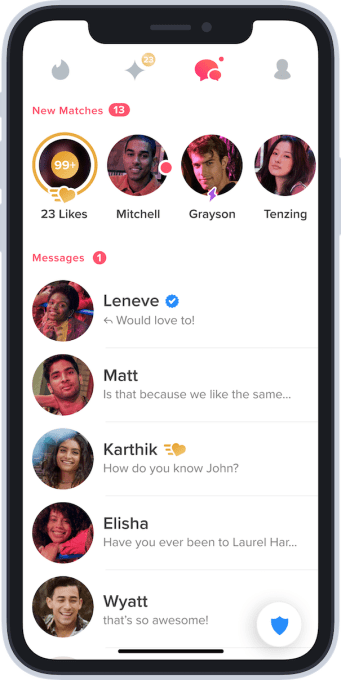
Image Credits: Tinder
The updates to both Tinder and Bumble came about following an investigation by the Australian Broadcasting Corporation, which found that 48 out of 231 survey respondents who had used Tinder said they had reported other users for some kind of sexual offense. But only 11 of those reports had received any replies, and even fewer offered specific information about what was being done.
The story had also explained how bad actors would take advantage of the dating app’s “unmatch” feature to hide from their victims. After unmatching, their chat history would disappear from the victim’s phone, which would have allowed the user to more easily report the abuse to Tinder or even to law enforcement, if needed.
Though Tinder was the focus of the story, Bumble quickly followed up to say it was changing how unmatching on its app would work. Instead of having the chat disappear when unmatched, Bumble users are now shown a message that says the other person has ended the chat. Here, they’re given the option to also either delete the chat or report it.
The ability to report the chat directly from the messaging inbox is what makes Bumble’s solution more useful. Tinder, on the other hand, is just redirecting users to what’s essentially its help documentation — the Tinder Safety Center — to learn how to go about making such a report. The addition of this extra step could end up being a deterrent to making these reports, as it’s less straightforward than simply clicking a button that reads “Report.”
Tinder also didn’t address the other issues raised by the investigation, which said many reports lacked follow-up or clear information about what actions Tinder was taking to address the issues.
Instead, the company says that it will continue to acknowledge when reports are received to let the member making the report know an appropriate action will be taken. Tinder added it will also direct users to trained resources for crisis counseling and survivor support; remove accounts if it finds account holders have been reported for violent crimes; and will continue to work with law enforcement on investigations, when required. These actions, however, should be baseline features for any dating app, not points of pride.
Tinder stressed, too, that it would not remove the unmatch feature, which is necessary for safety and privacy of its members. That seems to miss the point of what users’ complaints were about. Tinder users were not angry or concerned that an unmatching feature existed in the first place, but that it was being used by bad actors to avoid repercussions for their abuse.
The company didn’t say precisely when the changes to the dating app would roll out, beyond the “coming weeks.”
Today, Tinder’s parent company also announced a partnership with RAINN, a large anti-sexual violence organization, to conduct “a comprehensive review of sexual misconduct reporting, moderation, and response across Match Group’s dating platforms” and “to work together to improve current safety systems and tools.”
The organization will review Tinder, Hinge and Plenty of Fish to determine what best practices should be. Match says the partnership begins today and will continue through 2021.
“Every person deserves safe and respectful experiences, and we want to do our part to create safer communities on our platforms and beyond,” said Tracey Breeden, head of Safety and Social Advocacy for Match Group, in a statement. “By working together with courageous, thought-leading organizations like RAINN, we will up level safety processes and strengthen our responses for survivors of sexual assault. Safety challenges touch every corner of society. We are committed to creating actionable solutions by working collaboratively with experts to innovate on meaningful, industry-led safety approaches,” she added.
Powered by WPeMatico
Welcome back to This Week in Apps, the TechCrunch series that recaps the latest in mobile OS news, mobile applications and the overall app economy.
The app industry is as hot as ever, with a record 204 billion downloads and $120 billion in consumer spending in 2019. People now spend three hours and 40 minutes per day using apps, rivaling TV. Apps aren’t just a way to pass idle hours — they’re also a big business. In 2019, mobile-first companies had a combined $544 billion valuation, 6.5x higher than those without a mobile focus.
This week, Apple and Google announced their editorially curated lists detailing the best apps of the year, and Apple also revealed those that were downloaded the most. Apple also made a notable new hire for an App Store role and opened up its anticipated App Store Small Business Program to developers.
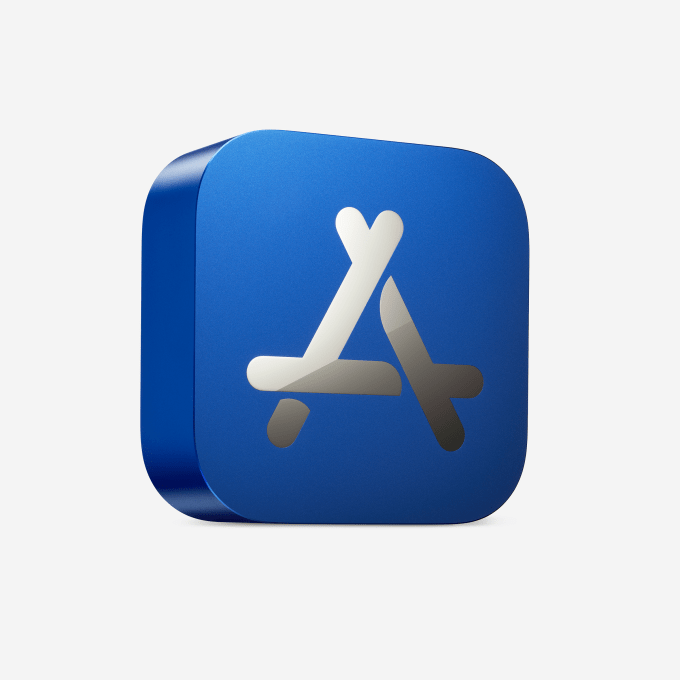
Image Credits: Apple
Both Apple and Google released their “best apps of 2020” year-end lists and there were some similarities between the two, as well as some differences. Both companies’ lists reflected the tough and stressful year 2020 has been, with everyone being stuck at home during a pandemic that changed how we worked, attended school, connected with friends and family, and entertained ourselves.
Apple and Google, as a result, both selected at least one “de-stressing” app among their year-end winners. In Apple’s case, it was Endel, an iOS app that won for Apple Watch App of the Year. Google, however, awarded sleep app Loóna the title of best app of the year.
Disney+ also made both Apple and Google’s lists, the former as Apple TV App of the Year and the latter as the User’s Choice for app of the year. The new streaming service was a godsend for families with younger children, who often struggled in 2020 to keep kids entertained. New releases like Onward and Mulan in 2020 helped give families something to look forward to, while Marvel and Star Wars content, including new series “The Mandalorian,” were hits with streamers, as well.
Another pandemic-prompted choice was Zoom, which won as iPad App of the Year. Though Zoom was around before the coronavirus outbreak, it’s now become a part of our everyday lexicon as an interchangeable term for “online video meeting” — as in, “let’s do a zoom call about that.” The iPad app at least made these endless virtual meetings a little less painless.
And home workout companion Wakeout! become Apple’s iPhone app of the year, as most people gave up the gym due to coronavirus risks. The app’s quick one-minute breaks helped users stay moving, even when stuck at home for days on the couch or working on their laptop in bed.

Image Credits: Genshin Impact (screenshot via Sensor Tower)
Meanwhile, gacha-based action role-playing game Genshin Impact won as “best game” of the year on both Apple and Google’s lists. While a cynical take is that the app stores wanted to point users to a huge moneymaker — the game reportedly earned $245 million its first month and nearly $400 million in two months on mobile — it also highlights consumers’ desire for console-like experiences on mobile.
The game, however, has been heavily criticized for its gacha game monetization techniques, which though common to games in China, Japan and South Korea, are basically gambling mechanics. And addictive ones at that. But as a Wired report noted, some of this comes down to cultural differences. U.S. users grew up on cartridge games, not arcade games, where you were constantly inserting more money to keep playing. Western users just aren’t as comfortable with this “spend to keep playing” business model, which they feel is predatory.
Apple’s other top apps of the year included perennial favorite Fantastical as Apple’s Mac App of the Year; Legends of Runeterra as iPad Game of the Year; Disco Elysium as Mac Game of the Year; Dandara Trials of Fear as Apple TV Game of the Year; and Sneaky Sasquatch as the Apple Arcade Game of the Year.
Google’s list also included SpongeBob: Krusty Cook-Off as users’ choice for best game, and it highlighted a variety of top titles in various gaming subgenres in a dedicated section of its Play Store.
Apple also gave a peek into the “best” apps of the year, as determined by app downloads. The pandemic played a role here as well, making Zoom the most-downloaded iPhone app of 2020.
Also of note, TikTok was the biggest social media app by downloads, ahead of all the Facebook-owned apps making the list, including Facebook, Instagram and Messenger. Square’s Cash App hit No. 10, as the pandemic saw increased demand for contactless payments and direct giving to people in need.
The most-downloaded apps and games of 2020 were, as follows:
VC Josh Elman announced this week he was joining Apple in a role that will see him helping customers “discover the best apps for them.” In other words, app discovery.
Elman’s background includes RealNetworks, LinkedIn, Zazzle, Facebook and Twitter, and later moved into VC. Elman worked at venture firm Greylock in 2011 as a principal, and by 2013 he had become a general partner. While there, he invested in SmartThings, as well as social networks like Musical.ly (now the massive No. 2 app of the year, TikTok), Nextdoor, Houseparty and Discord. He later moved to fast-rising fintech startup Robinhood and now, he’s heading to Apple.
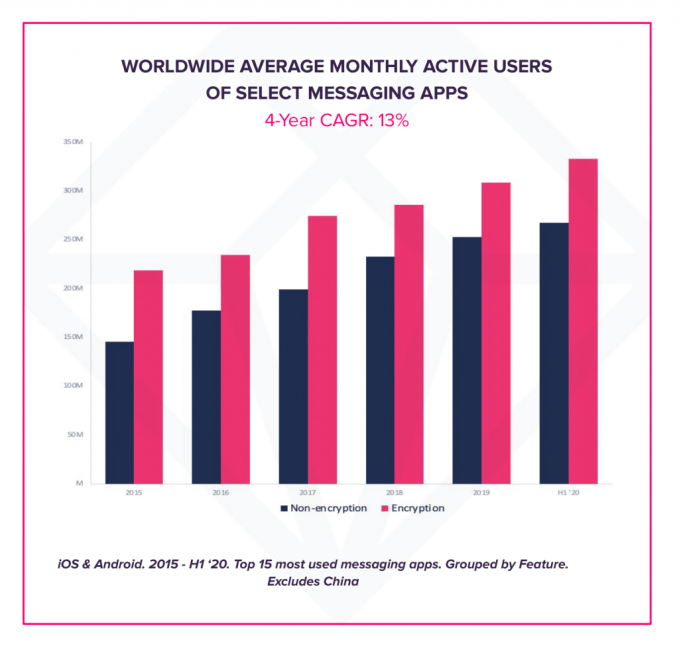
Image Credits: App Annie
We tried the Apple Watch Family Setup with a tween. They weren’t impressed with the apps or the controls, but did like the Memoji. No Roblox group chat on the small screen? Boo.
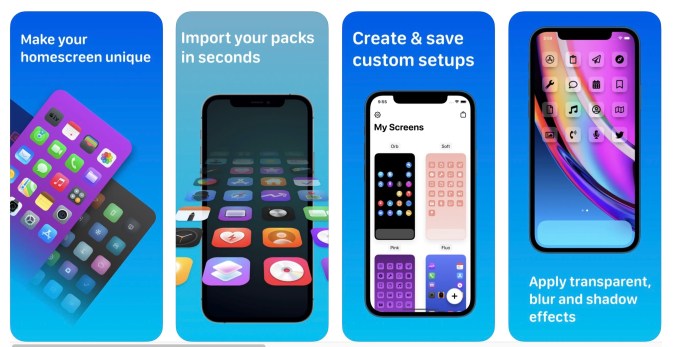
Image Credits: Iconboard
If you find it too frustrating to use Apple’s Shortcuts to build your own custom icons, you can turn to Iconboard instead. This newly launched app lets you design a style for your icons and apply it to all of your icons at once. It can even create invisible icons to give you a way to space out items on your screen.
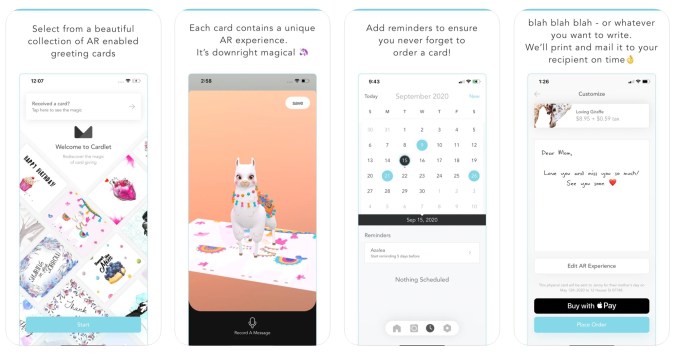
Image Credits: Cardlet
While I’ve been enjoying Punkpost’s custom designs for when I’m too lazy…err I mean busy…to send my own handwritten notes and cards, Cardlet is ready to give my go-to app a run for the money. Like Punkpost, Cardlet will send a real paper card on your behalf, but it adds a modern-day touch: The app includes a hidden AR experience that brings the card to life when viewed with the camera.
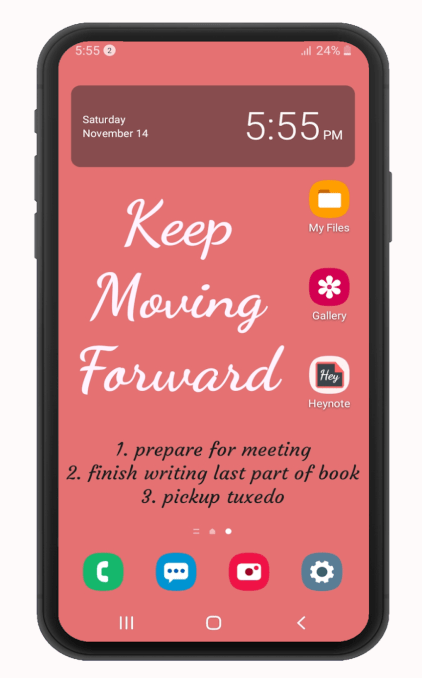
Image Credits: Heynote
Some people don’t trust to-do lists, reminders or calendar notifications to always get the job done. When there’s something we really need to remember, we stick it directly on our home screen. (Okay, this one may only appeal to a small niche of scatterbrained users like me.) But if you have, in the past, also designed your own temporary wallpaper just so you won’t forget a super critical appointment, the Android app Heynote, (hat tip to Android Police!) might help. Instead of a widget or reminder, this app lets you put custom text directly on your home screen as a custom wallpaper. Doctor appt. at 11 AM? You can’t forget it when it’s there every single time you look at your phone.
Powered by WPeMatico
Google announced this morning Android phones will receive an update this winter that will bring some half-dozen new features to devices, including improvements to apps like Gboard, Google Play Books, Voice Access, Google Maps, Android Auto and Nearby Share. The release is the latest in a series of update bundles that now allow Android devices to receive new features outside of the usual annual update cycle.
The bundles may not deliver Android’s latest flagship features, but they offer steady improvements on a more frequent basis.
One of the more fun bits in the winter update will include a change to “Emoji Kitchen,” the feature in the Gboard keyboard app that lets users combine their favorite emoji to create new ones that can be shared as customized stickers. To date, users have remixed emoji more than 3 billion times since the feature launched earlier this year, Google says. Now, the option is being expanded. Instead of offering hundreds of design combinations, it will offer more than 14,000. You’ll also be able to tap two emoji to see suggested combinations or double tap on one emoji to see other suggestions.
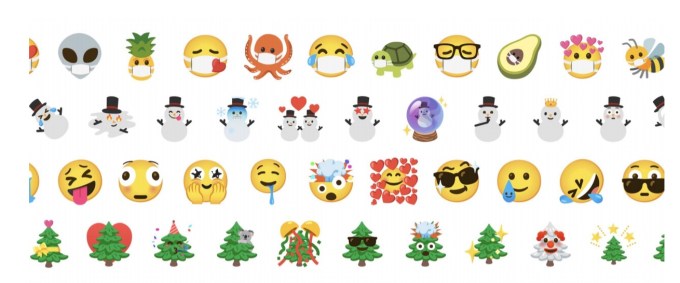
Image Credits: Google
This updated feature had been live in the Gboard beta app, but will now roll out to Android 6.0 and above devices in the weeks ahead.
Another update will expand audiobook availability on Google Play Books. Now, Google will auto-generate narrations for books that don’t offer an audio version. The company says it worked with publishers in the U.S. and U.K. to add these auto-narrated books to Google Play Books. The feature is in beta but will roll out to all publishers in early 2021.
An accessibility feature that lets people use and navigate their phone with voice commands, Voice Access, will also be improved. The feature will soon leverage machine learning to understand interface labels on devices. This will allow users to refer to things like the “back” and “more” buttons, and many others by name when they are speaking.
The new version of Voice Access, now in beta, will be available to all devices worldwide running Android 6.0 or higher.
An update for Google Maps will add a new feature to one of people’s most-used apps.
In a new (perhaps Waze-inspired) “Go Tab,” users will be able to more quickly navigate to frequently visited places — like a school or grocery store, for example — with a tap. The app will allow users to see directions, live traffic trends and disruptions on the route, and gives an accurate ETA, without having to type in the actual address. Favorite places — or in the case of public transit users, specific routes — can be pinned in the Go Tab for easy access. Transit users will be able to see things like accurate departure and arrival times, alerts from the local transit agency, and an up-to-date ETA.
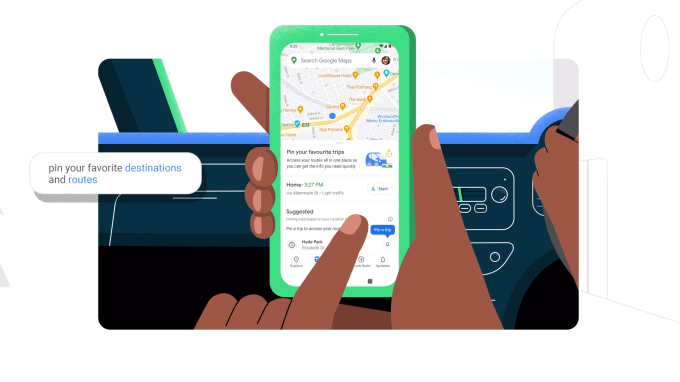
Image Credits: Google
One potentially helpful use case for this new feature would be to pin both a transit route and driving route to the same destination, then compare their respective ETAs to pick the faster option.
This feature is coming to both Google Maps on Android as well as iOS in the weeks ahead.
Android Auto will expand to more countries over the next few months. Google initially said it would reach 36 countries, but then updated the announcement language as the timing of the rollout was pushed back. The company now isn’t saying how many countries will gain access in the months to follow or which ones, so you’ll need stay tuned for news on that front.
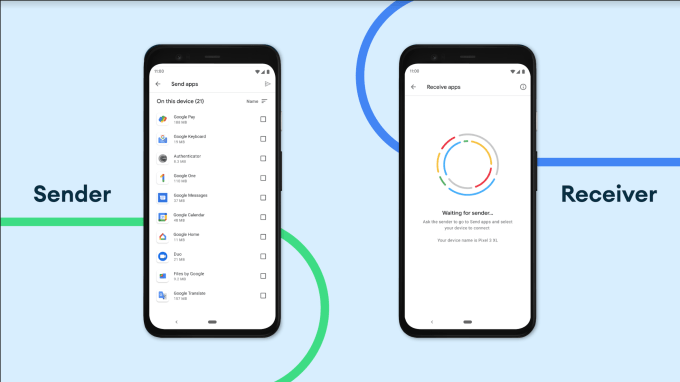
Image Credits: Google
The final change is to Nearby Share, the proximity-based sharing feature that lets users share things like links, files, photos and and more even when they don’t have a cellular or Wi-Fi connection available. The feature, which is largely designed with emerging markets in mind, will now allow users to share apps from Google Play with people around them.
To do so, you’ll access a new “Share Apps” menu in “Manage Apps & Games” in the Google Play app. This feature will roll out in the weeks ahead.
Some of these features will begin rolling out today, so you may receive them earlier than a time frame of several “weeks,” but the progress of each update will vary.
Powered by WPeMatico
Apple has always gone out of its way to build features for users with disabilities, and VoiceOver on iOS is an invaluable tool for anyone with a vision impairment — assuming every element of the interface has been manually labeled. But the company just unveiled a brand new feature that uses machine learning to identify and label every button, slider and tab automatically.
Screen Recognition, available now in iOS 14, is a computer vision system that has been trained on thousands of images of apps in use, learning what a button looks like, what icons mean and so on. Such systems are very flexible — depending on the data you give them, they can become expert at spotting cats, facial expressions or, as in this case, the different parts of a user interface.
The result is that in any app now, users can invoke the feature and a fraction of a second later every item on screen will be labeled. And by “every,” they mean every — after all, screen readers need to be aware of every thing that a sighted user would see and be able to interact with, from images (which iOS has been able to create one-sentence summaries of for some time) to common icons (home, back) and context-specific ones like “…” menus that appear just about everywhere.
The idea is not to make manual labeling obsolete — developers know best how to label their own apps, but updates, changing standards and challenging situations (in-game interfaces, for instance) can lead to things not being as accessible as they could be.
I chatted with Chris Fleizach from Apple’s iOS accessibility engineering team, and Jeff Bigham from the AI/ML accessibility team, about the origin of this extremely helpful new feature. (It’s described in a paper due to be presented next year.)
“We looked for areas where we can make inroads on accessibility, like image descriptions,” said Fleizach. “In iOS 13 we labeled icons automatically — Screen Recognition takes it another step forward. We can look at the pixels on screen and identify the hierarchy of objects you can interact with, and all of this happens on device within tenths of a second.”
The idea is not a new one, exactly; Bigham mentioned a screen reader, Outspoken, which years ago attempted to use pixel-level data to identify UI elements. But while that system needed precise matches, the fuzzy logic of machine learning systems and the speed of iPhones’ built-in AI accelerators means that Screen Recognition is much more flexible and powerful.
It wouldn’t have been possible just a couple of years ago — the state of machine learning and the lack of a dedicated unit for executing it meant that something like this would have been extremely taxing on the system, taking much longer and probably draining the battery all the while.
But once this kind of system seemed possible, the team got to work prototyping it with the help of their dedicated accessibility staff and testing community.
“VoiceOver has been the standard-bearer for vision accessibility for so long. If you look at the steps in development for Screen Recognition, it was grounded in collaboration across teams — Accessibility throughout, our partners in data collection and annotation, AI/ML, and, of course, design. We did this to make sure that our machine learning development continued to push toward an excellent user experience,” said Bigham.
It was done by taking thousands of screenshots of popular apps and games, then manually labeling them as one of several standard UI elements. This labeled data was fed to the machine learning system, which soon became proficient at picking out those same elements on its own.
It’s not as simple as it sounds — as humans, we’ve gotten quite good at understanding the intention of a particular graphic or bit of text, and so often we can navigate even abstract or creatively designed interfaces. It’s not nearly as clear to a machine learning model, and the team had to work with it to create a complex set of rules and hierarchies that ensure the resulting screen reader interpretation makes sense.
The new capability should help make millions of apps more accessible, or just accessible at all, to users with vision impairments. You can turn it on by going to Accessibility settings, then VoiceOver, then VoiceOver Recognition, where you can turn on and off image, screen and text recognition.
It would not be trivial to bring Screen Recognition over to other platforms, like the Mac, so don’t get your hopes up for that just yet. But the principle is sound, though the model itself is not generalizable to desktop apps, which are very different from mobile ones. Perhaps others will take on that task; the prospect of AI-driven accessibility features is only just beginning to be realized.
Powered by WPeMatico
VSCO, the popular photo and video editing app, today announced it has acquired AI-powered video editing app Trash, as the company pushes further into the video market. The deal will see Trash’s technology integrated into the VSCO app in the months ahead, with the goal of making it easier for users to creatively edit their videos.
Trash, which was co-founded by Hannah Donovan and Genevieve Patterson, cleverly uses artificial intelligence technology to analyze multiple video clips and identify the most interesting shots. It then stitches your clips together automatically to create a final product. In May, Trash added a feature called Styles that let users pick the type of video they wanted to make — like a recap, a narrative, a music video or something more artsy.
After Trash creates its AI-powered edit, users can opt to further tweak the footage using buttons on the screen that let them change the order of the clips, change filters, adjust the speed or swap the background music.

Image Credits: Trash
With the integration of Trash’s technology, VSCO envisions a way to make video editing even more approachable for newcomers, while still giving advanced users tools to dig in and do more edits, if they choose. As VSCO co-founder and CEO Joel Flory explains, it helps users get from that “point zero of staring at their Camera Roll…to actually putting something together as fast as possible.”
“Trash gets you to the starting point, but then you can dive into it and tweak [your video] to really make it your own,” he says.
The first feature to launch from the acquisition will be support for multi-clip video editing, expected in a few months. Over time, VSCO expects to roll out more of Trash’s technologies to its user base. As users make their video edits, they may also be able to save their collection of tweaks as “recipes,” like VSCO currently supports for photos.
“Trash brings to VSCO a deep level of personalization, machine learning and computer vision capabilities for mobile that we believe can power all aspects of creation on VSCO, both now and for future investments in creativity,” says Flory.
The acquisition is the latest in a series of moves VSCO has made to expand its video capabilities.
At the end of 2019, VSCO picked up video technology startup Rylo. A few months later, it had leveraged the investment to debut Montage, a set of tools that allowed users to tell longer video stories using scenes, where they could also stack and layer videos, photos, colors and shapes to create a collage-like final product. The company also made a change to its app earlier this year to allow users to publish their videos to the main VSCO feed, which had previously only supported photos.
More recently, VSCO has added new video effects, like slowing down, speeding up or reversing clips and new video capture modes.
As with its other video features, the new technology integrations from Trash will be subscriber-only features.
Today, VSCO’s subscription plan costs $19.99 per year, and provides users with access to the app’s video editing capabilities. Currently, more than 2 million of VSCO’s 100 million+ registered users are paid subscribers. And, as a result of the cost-cutting measures and layoffs VSCO announced earlier this year, the company has now turned things around to become EBITDA positive in the second half of 2020. The company says it’s on the path to profitability, and additional video features like those from Trash will help.
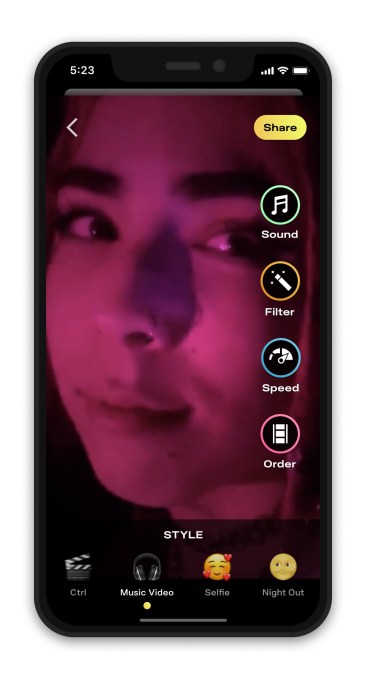
Image Credits: Trash
VSCO’s newer focus on video isn’t just about supporting VSCO’s business model, however, it’s also about positioning the company for the future. While the app grew popular during the Instagram era, today’s younger users are more often posting videos to TikTok instead. According to Apple, TikTok was the No. 2 most downloaded free app of the year — ahead of Instagram, Facebook and Snapchat.
Though VSCO doesn’t necessarily envision itself as only a TikTok video prep tool, it does have to consider that growing market. Similar to TikTok, VSCO’s user base consists of a younger, Gen Z demographic; 75% of VSCO’s user base is under 25, for example, and 55% of its subscribers are also under 25. Combined, its user base creates more than 8 million photos and videos per day, VSCO says.
As a result of the acquisition, Trash’s standalone app will shut down on December 18.
Donovan will join VSCO as Director of Product and Patterson as Head of Applied Research. Other Trash team members, including Karina Bernacki, Chihyu Chang and Drew Olbrich, will join as Chief of Staff, Engineering Manager and Sr. Software Engineer for iOS, respectively.
“We both believe in the power of creativity to have a healthy and positive impact on people’s lives,” said Donovan, in Trash’s announcement. “Additionally, we have similar audiences of Gen Z casual creators; and are focused on giving people ways to express themselves and share their version of the world while feeling seen, safe, and supported,” she said.
Trash had raised a total of $3.3 million — a combination of venture capital and $500,000 in grants — from BBG, Betaworks, Precursor and Dream Machine, as well as the National Science Foundation. (Multiple TechCrunch connections here: BBG is backed by our owner Verizon Media, while Dream Machine is the fund created by former TechCrunch editor Alexia Bonatsos.)
“Han and Gen and the Trash team have always paid attention to the needs of creators first and foremost. My hope is that the VSCO and Trash partnership will turn all of us into creators, and turn the gigabytes of latent videos on our phones from trash to treasures,” said Bonatsos, in a statement about the deal.
Flory declined to speak to the deal price, but characterized the acquisition as a “win-win for both the Trash team and for VSCO.”
Updated 12/3/20, 11:27 AM ET: VSCO alerted us that Patterson’s title is being updated to “Head of Applied Research.” We’ve updated the article accordingly.
Powered by WPeMatico